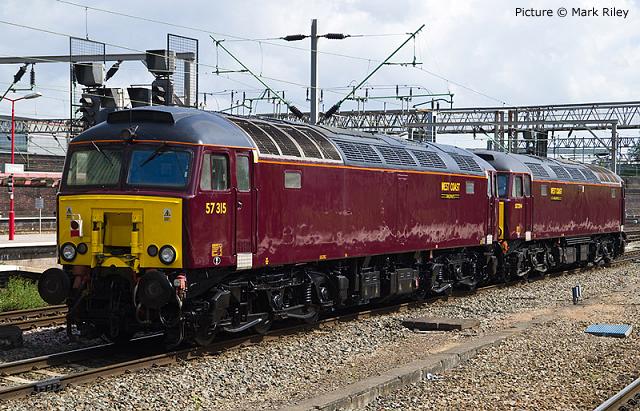Historical notes
When Virgin Trains arranged to have some Class 47 locos rebuilt with General Motors engines as Class 57/3, it was envisaged that they would be used principally for rescuing failed trains, and for hauling Class 390 'Pendolino' electric trains over non-electrified sections during diversions for engineering work. Class 221 Voyager diesels were to have covered all the Holyhead - London workings; four of these had been built as four-car sets rather than five-car for this purpose and allocated to the Virgin West Coast franchise, all other 221s being Virgin CrossCountry stock.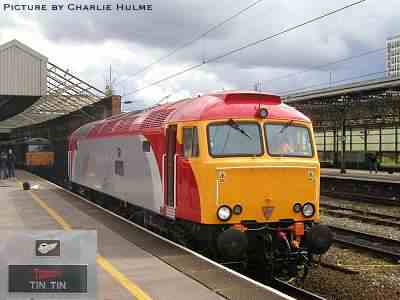
It had become a railway tradition to refer to locos stationed around the network for rescue purposes 'Thunderbirds' after the famous TV show, and Virgin took this one step further by arranging for the 57/3s to be named for characters in the series. Cleverly, the first five have the final digit of their numbers the same as the relevant character's transport in the stories. 57 301 is Scott Tracy, who piloted Thunderbird 1, etc. 57 307 Lady Penelope has pink-backed nameplates to match the colour of the lady's Rolls-Royce. Our picture shows 57 311 Tin Tin fresh out of the Brush works at Loughborough.
In Summer 2003, during the process of creation of the 57/3s, a change of plan occurred; legend has it that this was brought about by the desire of North Wales MPs for a full breakfast service when travelling to London, something that the small Class 221 galley could not offer. Two weekday return workings to London would therefore be Pendolinos, hauled by Class 57/3s between Holyhead and Crewe. The original order for locos was increased from 12 to 16, and the fitting of a 'Dellner' automatic coupler to the locos was hastily designed, so that the coupling and uncoupling at Crewe could be done more quickly than by using the 390's emergency screw-coupling as had originally been envisaged for 'dragging' and diversion work.
After 12 locos, there were no Thunderbirds characters left to use for names, so places and things from the show were resorted to for the final four.
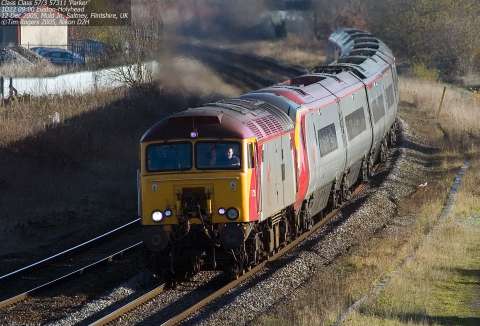
By January 2004 we were reporting that the couplers were in process of fitting, and work was under way to modify the exhaust system of the locos to prevent diesel fumes entering the 390's air-conditioning. At one time it was thought that the 57/3 might have to push the train, but eventually this was resolved. Then the whole plan nearly foundered as it was discovered that a Pendolino, with its pantograph in the lowered position, was too high for the 'structure gauge' in North Wales, and Network Rail had to do some work to allow them to run. But after all these problems were overcome, Pendolino service did begin in Spring 2005. The weekday turns were, at various times, supplemented by summer weekend operations to release Class 221s to relieve overcrowding elsewhere in Britain. The two weekday trains, and some weekend workings, continued as Pendolinos until the December 2008 timetable change, after which only a single Saturday-only Pendolino return working remained. This was suspended for a while, but from May 2009 began running again, to maintain staff familairity with the procedure.
By 2008 Virgin Trains had found that they had too many locos for their requirements, even though they were already hiring them out for use on timber trains to Chirk. Arriva Trains Wales were being asked by the Welsh Assembly Government to provide a loco-hauled express from North Wales to Cardiff, and Virgin Trains successfully bid to supply the locos, to be driven by ATW drivers, who were given a referesher course, as ATW had used the 'Thunderbirds' for a while a couple of years before.
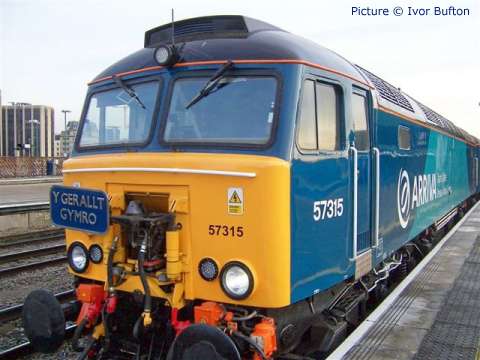
The last four locos, 313 - 316 were chosen, perhaps because their 'vehicle' names (Tracy Island, Firefly, The Mole, FAB 1) not match the 'character' names of the other twelve. 57 314 and 57 315 were de-named and re-liveried in a new version of Arriva Trains Wales colours for use on the Monday - Friday express from Holyhead to Cardiff and return, which commenced on 15 December 2008. 57 313 and 57 316 appeared shortly afterwards, de-named, in a so-called 'neutral' livery - the same blue but minus the lighter parts, and the logos - and are supposedly used 'when the branded locos are unavailable' (although in practice they appeared just as often as the branded ones). The Arriva service was taken over by DB Schenker Class 67s from the evening working of 26 March 2012.
In 2010 57s were replaced by Colas Rail Class 66s on timber traffic to Chirk; from December 2009 on they could be seen on First Great Western loco-hauled trains in south-west England, but were soon removed from this duty due to unreliability.
In August 2011, six of the locos were given up by Virgin for further use by Network Rail, and were repainted in NR's all-yellow livery. Changes were made to their couplers to allow them to haul various types of electric railcars used in the south-east. The nameplates were removed for sale in a charity auction. In March 2012 three more locos were de-branded, this time for transfer to DRS, and received DRS blue livery. In 2014, Network Rail decided to give up its locos, and all six have passed to DRS and gained its livery.
As for the four Arriva blue ones 313 - 316, at the start of 2013 they were sold to charter train operator West Coast Railway Company and when repainted have appeared in maroon livery; they make occasional forays to North Wales on excursions.
Farewell to North Wales
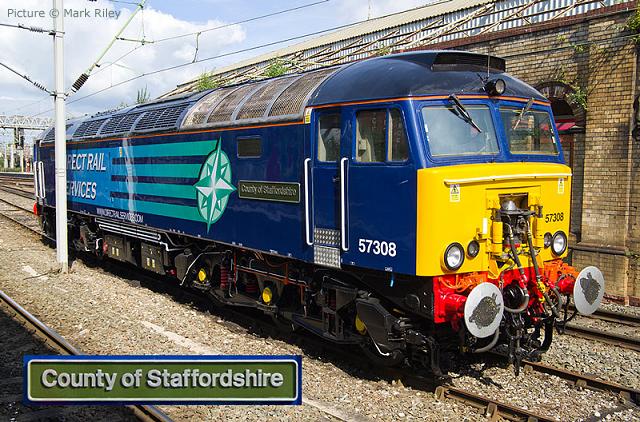
At the December 2012 timetable change, marking the end of Virgin's franchse term (although an abnormal extension was awarded to the company following much-publicised fisaco relating to the award of the next franchise) the story of Class 57s and Pendolinos come to an end as far as the normal working of the North Wales line is concerned.
It was planned to replace the solitary Saturday train with a pair of Class 221 Voyagers after the workings of 8 December, but in view of a series of problems in previous weeks, culminating in a failure to establish a control connection between loco and train on 1 December resulting in passengers being transferred to a Voyager at Crewe, it was decided to begin Voyager service a week early on 8 December, to the dismay of railfans who had hoped for a last ride.
The three 57/3 locos which remained allocated to Virgin and in their livery (307, 308, 311) transferred to the DRS fleet, and ceased to be the maintenance responsibilty of Alstom's Manchester Longsight depot. All are expected to receive DRS livery. By 7 December it was reported that 57 307 had already been sent to Eastleigh Works. Interestingly when it emerged in DRS blue livery the pink 'Lady Penelope' nameplates were retained - a nice gesture by DRS. In spring 2013 57 311 was re-named simply as 'Thunderbird' with a standard style nameplate.
In future provide the Class 57/3 locomotives for 'rescue' duty are hired by Virgin from DRS, although staffed by Virgin drivers, and will normally be located at Euston, Rugby, Crewe, Preston and Carlisle stations.
DRS locos are also likely to appear from time to time on passenger charter trains in North Wales and elsewhere.
Names
of Class 57/3 locomotives
(original Class 47
numbers in brackets)57 301 N (47 845)Livery: Originally, all were Virgin red and silver. later 313-316 were painred blue for Arriva Trains Wales duty. By january 2016, liveries as follows:
57 302 D (47 827) Chad Varah
57 303 N (47 705)
57 304 D (47 807) Pride of Cheshire
57 305 B (47 822) Northern Princess
57 306 D (47 814)
57 307 D (47 225) Lady Penelope
57 308 D (47 846) County of
Staffordshire
57 309 D (47 806) Pride of Crewe
57 310 D (47 831)
57 311 D (47 817) Thunderbird
57 312 B (47 330) Solway Princess
57 313 W (47 371)
57 314 W (47 372)
57 315 W (47 234)
57 316 W (47 290)
D: DRS blue.
W West Coast Railways maroon.
B: Northern Belle brown and cream
Class 390
Pendolinos
(the last two digits of
each coach number match the unit number)Units being extended to 11 cars have 100 added to their number.
390 001 Virgin Pioneer
390 002 Virgin Angel
390 103 % Virgin Hero
390 104 %+ Alstom Pendolino
390 005 City of Wolverhampton
390 006 Tate Liverpool
390 107 % Virgin Lady
390 008 Treaty of Union
390 009 Virgin Queen
390 010 A Decade of Progress
390 011 City of Lichfield
390 112 % Virgin Star
390 013 Virgin Spirit
390 114 % City of Manchester
390 115 % Virgin Crusader
390 016 Virgin Champion
390 017 % Virgin Prince
390 118 % Virgin Princess
390 119 % Virgin Warrior
390 020 Virgin Cavalier
390 121 % Virgin Dream
390 122 % Penny the Pendolino
390 123 % Virgin Glory
390 124 % Virgin Venturer
390 125 % Virgin Stagecoach
390 126 % Virgin Enterprise
390 127 % Virgin Buccaneer
390 128 % City of Preston
390 129 % City of Stoke on Trent
390 130 % City of Edinburgh
390 131 % City of Liverpool
390 132 % City of Birmingham
390 033 * City of Glasgow
390 134 % City of Carlisle
390 135 % City of Lancaster
390 136 % City of Coventry
390 137 % Virgin Difference
390 138 % City of London
390 039 Virgin Quest
390 040 Virgin Pathfinder
390 141 % City of Chester
390 042 City of Bangor /
Dinas Bangor
390 043 Virgin Explorer
390 044 Virgin Lionheart
390 045 101 Squadron
390 046 Virgin Soldiers
390 047 CLIC Sargent
390 148 % Virgin Harrier
390 049 Virgin Express
390 050 Virgin Invader
390 151 % Virgin Ambassador
390 152 % Virgin Knight
390 153 % Mission Accomplished
390 154 +
390 155 Matthew Flinders
390 156 Stockport 170
390 157 Chad Varah
* 390 033 was severely damaged in the Greyrigg
derailment on 23 February 2007, and will not re-enter service.
+ Alstom livery variant. was re-liveries named 'X-Man: dad of future past' in 2014 but this may be temporary.
390 155 was named 'Rugeley Town' but this has been replaced by
Matthew Flinders, which might seem more appropriate to a 'Voyager' unit.
% 11-car unit
Note: renamings of 390s, usually the 'Virgin ...'
examples, are common: 390 047 carries the name of the charity currently
being supported by Virgin.
Pendolino
The Class 390 Pendolinos had a rather chequered early career, being delivered late by Alstom, and turning out to be the last trains built at the old Metro-Cammell factory in Birmingham before it was closed down by its multinational parent. There were originally 8-car sets, then a ninth car was built and added to each set.
On 23 February 2007 390 033 was involved in a derailment on faulty points at Grayrigg in Cumbria. Several coaches fell down an embankment, and although only one passenger died, the damage to the train was such that it was decided not to repair it.
Orders were placed by the Department for Transport in 2008 to build our new sets will be built with 11 cars each, and plus new vehicles to enable 31 of the existing fleet to be lengthened to 11-car format. These are being built in Italy; the first 11-car set, 390 054, was delivered in 2011, and temporarily reduced to 9 cars for operation by Virgin Trains, although the new trains are intended for use by whoever wins the West Coast Mail Line franchise when it is re-let in 2012. By late 2012 all four new sets were running in 11-car formation, and the 31 others had also had the extra two cars incorporated.
The original naming theme of the Pendolinos was a mixture of cities served by Virgin - featuring the crest of the city - and 'Virgin' names inspired by - but not all copied from - the old Class 52 'Western' class diesel-hydraulic locos, which were apparently a favourite of Richard Bowker, the head of Virgin Trains at the time. Over the years several have been re-named to celebrate various events.
